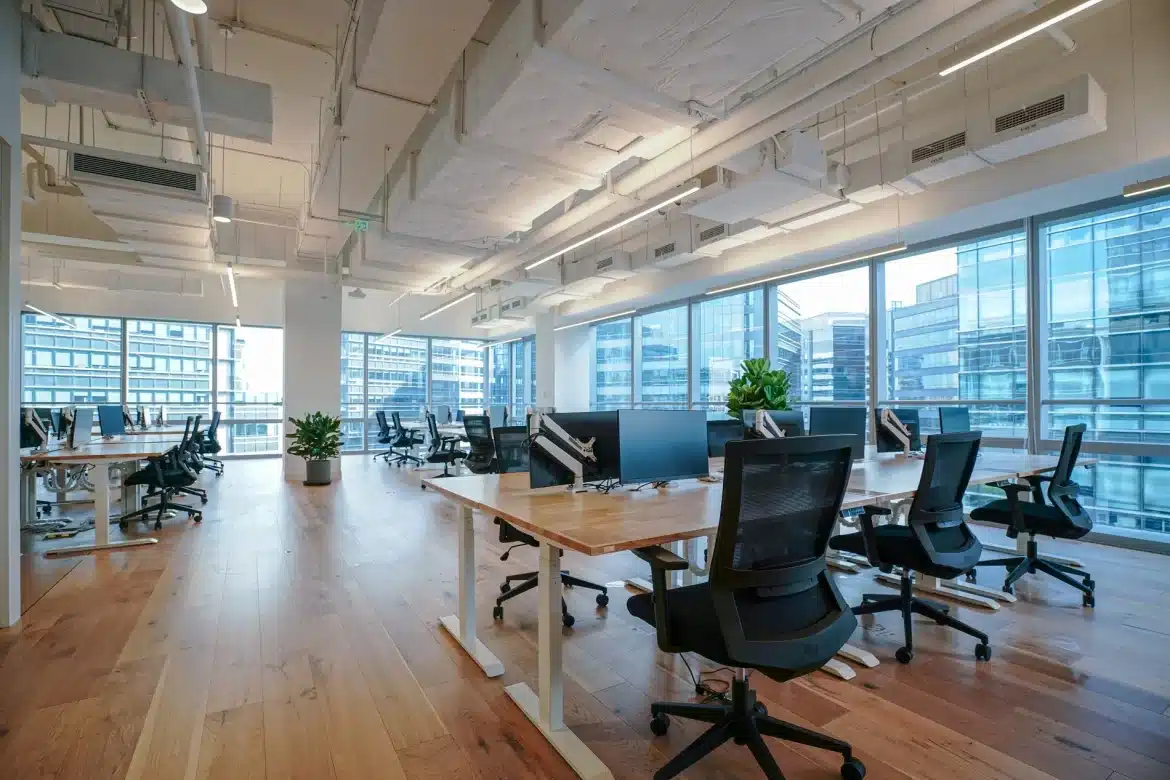The landscape of the modern workplace has undergone several transformative changes over the past two decades – from the traditional cubicle-dominated spaces in the early 2000s to the more contemporary open-plan layouts in the 2010s. Today, a more playful shift can be observed, as offices began to integrate leisurely elements such as ping pong and foosball tables, embracing a more relaxed and communal atmosphere.
But while trends in office design may wax and wane, the influence of a work environment on your employees’ health and well-being remains a constant and paramount concern.
This is why more and more business leaders are recognizing that the physical setting where workers perform their daily tasks is a critical component that can either stimulate a stress-reduced, highly efficient workplace or detract from it.
Thus, organizations must thoughtfully consider and actively design workspaces that evoke comfort and tranquillity, creating an environment that not only nurtures the employees’ well-being but also paves the way for them to deliver their utmost performance and creativity. After all, a well-conceived office design is an investment in a company’s most valuable asset – the workers who spend significant hours at their workplaces.
Why You Need A Healthy Office Space
 Maintaining a clean and healthy workspace transcends mere cosmetic appeal; it is intricately linked to the functionality, productivity, and overall well-being of your team, and this principle holds true regardless of the scale at which you operate, be it a nimble start-up or a sprawling corporate entity.
Maintaining a clean and healthy workspace transcends mere cosmetic appeal; it is intricately linked to the functionality, productivity, and overall well-being of your team, and this principle holds true regardless of the scale at which you operate, be it a nimble start-up or a sprawling corporate entity.
According to a recent survey conducted by the online office agency Free Office Finder, several factors inherent to some office environments significantly impact employee health and overall business productivity, such as the absence of natural lighting, inadequate fresh air, and distracting noise levels. These elements are detrimental to workplace well-being, creating conditions that are not conducive to employee satisfaction or efficiency.
Interestingly, the data reveals that younger employees, specifically those aged 18-34, are the most sensitive to these suboptimal conditions, showing a noticeable decline in productivity when working in poorly designed office spaces.
Business productivity is also hindered by the spatial design of offices, as many workplaces lack designated quiet areas where employees can retreat to recharge or focus deeply without interruptions, and some are even described as impersonal and unwelcoming, further detracting from the overall workplace ambiance.
Top Strategies for A Healthier Office Environment

Thus, employers who embrace this philosophy are not only investing in their employees’ physical and mental health but are laying the foundation for a more productive, innovative, and resilient organization. As you consider steering your organization towards a cleaner and healthier workspace, here are some of the proactive steps you can undertake:
1. Establish A Daily Cleaning Routine
Regular cleaning reduces the accumulation of dust, allergens, and germs, decreasing the likelihood of sickness spreading among staff, which is beneficial for both physical and mental well-being because a clutter-free environment reduces stress, enables clearer thinking, and boosts productivity.
Start by identifying key areas that require attention, such as communal spaces, workstations, and restrooms, then break down tasks into manageable chunks to ensure they don’t become overwhelming. “Larger offices with more staff members or regular visitors might require daily commercial office cleaning services, especially in high-traffic areas,” says Mike Derryberry of Compass Cleaning Solutions.
2. Prioritize Ergonomic Design
Ergonomics is an essential field of study focused on tailoring the work environment to fit the natural physical abilities or limitations of employees, and neglecting to consider this can result in employees feeling both frustrated and exhausted, negatively impacting their productivity and the quality of their work.
To prevent such issues from arising, consider incorporating ergonomic furniture and tools into the office setup, such as chairs that can be adjusted to fit the individual’s body, desks that allow standing to encourage posture variation, and keyboards designed to support natural hand positioning.
These adjustments alleviate physical strain and discomfort and significantly decrease the likelihood of developing musculoskeletal disorders.
3. Enhance Air And Water Quality
The quality of the air you breathe and the water you drink at work directly impacts your health, cognitive function, and energy levels, which is why poor air quality can lead to respiratory problems, decreased concentration, and increased fatigue, while poor water quality can affect digestion, hydration, and mental clarity.
You can improve air quality by introducing air purifiers and indoor plants in critical areas, especially in closed spaces where air circulation might be limited, since these can reduce pollutants and allergens, providing a cleaner breathing environment for everyone.
Water quality can be addressed by investing in high-quality water filtration systems, so your team can access clean, safe drinking water, thus supporting their health and encouraging proper hydration – both crucial in maintaining focus and energy.
4. Optimize Natural Lighting
Access to natural light in your office can significantly enhance mood and boost energy levels while alleviating common discomforts such as eye strain and headaches.
As such, try to include as many windows as possible and arrange workstations to receive maximum daylight exposure when designing office spaces since doing so can brighten your workspace as well as create a more inviting and productive environment.
In areas where natural light cannot reach, consider installing artificial lighting solutions that replicate the qualities of natural light, effectively mimicking the spectrum of daylight, thus helping to maintain energy levels and reducing the risks associated with inadequate lighting, such as fatigue and decreased visual acuity.

